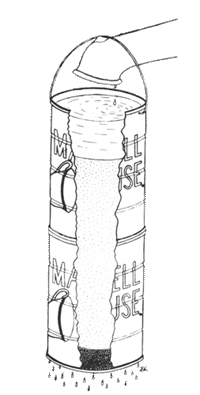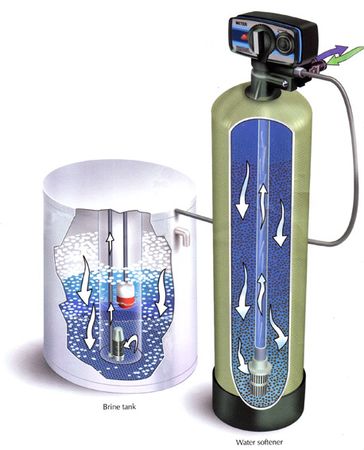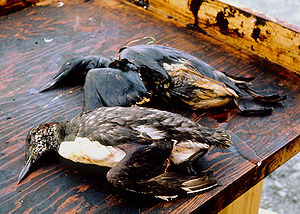June 2010
Go here if you'd like to read this issue on our website.
An email extension of the Pure Water Gazette.
In this issue of the Occasional you'll hear about the Water Security Index, Zeolite, phosphorous, and arsenic poisoning in Bangladesh. Read about Pure Water Annie, Hugo Chavez, Emmett Culligan, Naomi Klein, and octogenarian Jean Hill. Learn who got the very first certification for reactivated filter carbon, why the Upper Delaware has been designated America's most endangered river, and why MOM's Organic Market has stopped selling bottled water. Learn what makes water hard and the role coffee played in the invention of the water softener. Hear how (but not why) crocodiles cross oceans, where there is more water than was previously believed, and what even the President cannot order pelicans not to do (no matter whose ass he kicks). And, as always, much, much more. The Occasional is overseen and edited by Pure Water Gazette editor in chief Hardly Waite.
Water News from Around the World
While you weren't paying attention early this summer, a lot of important things happened. Follow the links if you want to catch up.
Dallas County government was brought to a standstill for several days by a water main break.
The beautiful and historic Upper Delaware River has been designated America’s most endangered river because of rampant natural gas drilling.
Venezuelan President Hugo Chavez criticized Coca Cola and Pepsi for abuse of the nation’s water and hinted that he may nationalize the soft drink giants.
Finally, the mystery of how crocodiles cross oceans has been discovered.
MOM's Organic Market
has halted bottled water sales in all its outlets in an effort to reduce
the use of plastics. The stores will
offer “fill-your-own-bottle” machines instead..
The Gulf oil leak has kept some really scary natural gas fiascos out of the mainstream news.
Boycotting BP is much more complicated than people think.
It appears that there is a lot more water on the moon than anyone thought.
“Between 1971 and 2000, the U.S. Coast Guard identified more than 250,000 oil spills in U.S. waters totaling 6.18 MMbbl.” The Coast Guard has issued a report that will tell you more than you want to know about oil spills.
It was revealed that a Hudson River nuclear plant requires 2.5 billion gallons of water per day for cooling and that it kills over one billion river creatures per year.
In what is probably bad news for ground water, the US Supreme court ruled that a Monsanto genetically modified alfalfa seed, which has been only partially tested, can be used without further testing.
Time magazine reports that millions in Bangladesh have been poisoned by arsenic resulting from a well-intentioned well drilling program. The World Health Organization has called it “the largest mass poisoning of a population in history.” And don’t think you’re safe from arsenic just because you live in the United States.
The city of Cedarburg, WI has an alarming amount of vinyl chloride in its water, due probably to seepage from an abandoned landfill.
A “Water Security Index” has ranked the relative water security of 165 countries. New Zealand comes out on top.
Eighty-two year old Jean Hill has succeeded in getting a ban on bottled water sales passed in Concord, MA. Bottled water manufacturers are threatening to sue.
U.S. filter media manufacturer Calgon Carbon (maker of Centaur catalytic carbon, among other high quality products) has received the first NSF certification for reactivated filter carbon.
The state of Washington
has passed a law requiring dishwasher detergents to contain far less
phosphorous. It is estimated that 10% to
12% of wastewater phosphorous comes from automatic dishwasher detergents. (Phosphorous encourages growth of algae,
depleting water of oxygen, and consequently killing fish.)
All About Water Softeners
The water softener is the flagship product of the modern water treatment industry. Traditional water treatment "dealerships" have been built around the water softener for decades.
The softener is commonly said to have been introduced in 1903, although the details of its origin are sketchy.
Here is the Culligan version of the origin of the softener, from Culligan's website:
Emmett Joseph Culligan grew up in a farming background in the
hard water areas of South Dakota, Iowa and Minnesota.
He was well aware of the difference between hard well water and the soft rain
water most families collected in cisterns. The 9th day of January, 1921, was
probably the most significant day of his life. As an expectant father he was
pacing the halls at St. Joseph¹s Hospital and ended up in the boiler
room. He struck up a conversation with the maintenance superintendent. Next to
the boilers were two large cylindrical tanks which the superintendent proudly
announced softened the water to prevent scaling in the boilers and save
soap in the hospital laundry.
 The
superintendent then explained how he could prevent diaper rash by building his
own softener to use to wash his baby's diapers.
The
superintendent then explained how he could prevent diaper rash by building his
own softener to use to wash his baby's diapers.
Culligan exhibited a tremendous interest in the hospital water softener and
finally prevailed upon the superintendent to give him a coffee can full of the
greenish-black mineral, called Zeolite, which "magically" removed the
hardness from water.
The superintendent explained how Culligan could punch some pinholes in the
bottom of the coffee can, put about an inch of coarse sand in the bottom, and
then fill it with the green sand Zeolite. The superintendent told him he could
hold this "coffee can softener" under the faucet, let hard water
trickle through the device into a wash basin and the resulting water would
be softer than rain.
So fascinated was Emmett with his first
encounter with ion exchange that the expectant father almost forgot why he was
at the hospital. The nurses had searched, from one end of the halls to the
other, before locating him in the boiler room to announce that he was the
father of a healthy baby daughter.
The rest is history.
At Pure Water Products we have a different version. It's about how part of man's punishment for the apple eating incident was being deprived of the naturally soft water in the garden. To spare humans the anguish of spotty glassware and excessive soap consumption, Pure Water Annie (founder of Pure Water Products) invented the water softener just a few days after the great flood.
That's a lot more likely than the coffee can myth. Anyway, what was Emmett Culligan doing in the hospital's boiler room?
At right, the original softener invented by Pure Water Annie. Compare the advanced design with Emmett Culligan's primitive coffee can softener above.Photo Courtesy of Smithsonian Institute. |
 |
How Water Softeners Work
Now that we've established the origin of the softener, here's a brief description of how water softeners function.

The diagram above shows the two parts of a standard residential water softener. On the left, the brine tank, which holds the salt that regenerates the unit, and on the right, the water softener itself.
A water softener is an ion exchanger. It is not a water filter.
Hard water—water with a high calcium/magnesium content—enters the softener through the “In” port indicated by the green arrow. It passes through the control valve and into the main tank, where it goes from top to bottom through a bed of resin that “softens” it.
Though early softening devices used natural zeolites as the softening medium, modern softeners use a resin which consists of specially manufactured beads that have been saturated with sodium ions. “Softening” occurs as the hardness minerals, the calcium and magnesium ions, in the water attach themselves to the resin and are “exchanged” for sodium, which leaves the resin and goes into the water in their place.
The softened water then enters the long center tube, called a riser, via the strainer basket in the bottom of the tank and passes upward through the riser. The water then exits the softener via the control valve (purple arrow) and is sent to the home.
When the resin becomes saturated by hardness minerals, it no longer has the ability to soften water. The water softener then goes into regeneration. The regeneration process is initiated by a timer or a meter, depending on the type of softener. By this process the hardness minerals are washed down the drain (via a drain tube not shown in the diagram), and the resin bed is rinsed, resettled, and recharged with sodium, drawn from the brine tank via the small tube that connects the two tanks. It is now again ready to soften water.
The regeneration process is accomplished by passing very salty water from the brine tank through the resin. The brine solution is so concentrated that its high sodium content displaces the calcium and magnesium ions on the resin.
The brine tank must remain filled with softener salt at all times so that it can regenerate the softening resin again and again.
For more about how softeners work, especially the metered variety, visit our How It Works section on the Occasional's website.
Featured Water Issue: Hardness
Hardness in water, technically, is determined by the content of calcium and magnesium salts. These salts are formed when calcium and magnesium combine with bicarbonates, sulfates, chlorides, and nitrates.
The standard measurement of hardness in water is "grains per gallon," with a grain representing 17.1 parts per million. Grains per gallon is usually reported "as calcium carbonate" (CaCO3) to facilitate comparison with other constituents of the water.
There are a variety of definitions of where "hard" water begins, but there is general agreement that water of 7 grains per gallon or more is hard enough that things would be improved by a water softener.
Hardness has undesirable side effects for residential water users. Notably, hardness forms a hard scale in pipes and appliances that shortens their life and deceases their effectiveness. Recent studies have shown that hardness scale in hot water heaters wastes large amounts of energy by making the heater less efficient. Hard water also requires the use of more laundry products.
The standard treatment for hardness is the cation exchanger, commonly know as a water softener. Reverse osmosis also removes hardness but it is usually not a practical treatment because hardness is harmful to reverse osmosis membranes. There are also alternative treatments, many of them controversial, that do not remove the hardness minerals but condition them so that they are less harmful.
More information about hardness on this site.

Obama cannot order pelicans not to die (no matter whose ass he kicks). And no amount of money – not BP’s $20bn, not $100bn – can replace a culture that’s lost its roots.--Naomi Klein.
Gulf Oil Spill: A Hole in the World
by Naomi Klein
--This month the Guardian published a superb comment on the Gulf oil disaster by noted researcher Naomi Klein. The article is a moving look at various dimensions of the tragedy that have been ignored by the conventional media. We're printing only the final segment of the article, "Make the bleeding stop," but we urge you to read the entire essay in the original Guardian version.--Hardly Waite, Editor, Pure Water Gazette.
Make the bleeding stop
Thankfully, many are taking a very different lesson from the disaster, standing not in wonder at humanity's power to reshape nature, but at our powerlessness to cope with the fierce natural forces we unleash. There is something else too. It is the feeling that the hole at the bottom of the ocean is more than an engineering accident or a broken machine. It is a violent wound in a living organism; that it is part of us. And thanks to BP's live camera feed, we can all watch the Earth's guts gush forth, in real time, 24 hours a day.
John Wathen, a conservationist with the Waterkeeper Alliance, was one of the few independent observers to fly over the spill in the early days of the disaster. After filming the thick red streaks of oil that the coast guard politely refers to as "rainbow sheen", he observed what many had felt: "The Gulf seems to be bleeding." This imagery comes up again and again in conversations and interviews. Monique Harden, an environmental rights lawyer in New Orleans, refuses to call the disaster an "oil spill" and instead says, "we are haemorrhaging". Others speak of the need to "make the bleeding stop". And I was personally struck, flying over the stretch of ocean where the Deepwater Horizon sank with the US Coast Guard, that the swirling shapes the oil made in the ocean waves looked remarkably like cave drawings: a feathery lung gasping for air, eyes staring upwards, a prehistoric bird. Messages from the deep.
And this is surely the strangest twist in the Gulf coast saga: it seems to be waking us up to the reality that the Earth never was a machine. After 400 years of being declared dead, and in the middle of so much death, the Earth is coming alive.
The experience of following the oil's progress through the ecosystem is a kind of crash course in deep ecology. Every day we learn more about how what seems to be a terrible problem in one isolated part of the world actually radiates out in ways most of us could never have imagined. One day we learn that the oil could reach Cuba – then Europe. Next we hear that fishermen all the way up the Atlantic in Prince Edward Island, Canada, are worried because the Bluefin tuna they catch off their shores are born thousands of miles away in those oil-stained Gulf waters. And we learn, too, that for birds, the Gulf coast wetlands are the equivalent of a busy airport hub – everyone seems to have a stopover: 110 species of migratory songbirds and 75% of all migratory US waterfowl.
It's one thing to be told by an incomprehensible chaos theorist that a butterfly flapping its wings in Brazil can set off a tornado in Texas. It's another to watch chaos theory unfold before your eyes. Carolyn Merchant puts the lesson like this: "The problem as BP has tragically and belatedly discovered is that nature as an active force cannot be so confined." Predictable outcomes are unusual within ecological systems, while "unpredictable, chaotic events [are] usual". And just in case we still didn't get it, a few days ago, a bolt of lightning struck a BP ship like an exclamation mark, forcing it to suspend its containment efforts. And don't even mention what a hurricane would do to BP's toxic soup.
There is, it must be stressed, something uniquely twisted about this particular path to enlightenment. They say that Americans learn where foreign countries are by bombing them. Now it seems we are all learning about nature's circulatory systems by poisoning them.
In the late 90s, an isolated indigenous group in Colombia captured world headlines with an almost Avatar-esque conflict. From their remote home in the Andean cloud forests, the U'wa let it be known that if Occidental Petroleum carried out plans to drill for oil on their territory, they would commit mass ritual suicide by jumping off a cliff. Their elders explained that oil is part of ruiria, "the blood of Mother Earth". They believe that all life, including their own, flows from ruiria, so pulling out the oil would bring on their destruction. (Oxy eventually withdrew from the region, saying there wasn't as much oil as it had previously thought.)
Virtually all indigenous cultures have myths about gods and spirits living in the natural world – in rocks, mountains, glaciers, forests – as did European culture before the scientific revolution. Katja Neves, an anthropologist at Concordia University, points out that the practice serves a practical purpose. Calling the Earth "sacred" is another way of expressing humility in the face of forces we do not fully comprehend. When something is sacred, it demands that we proceed with caution. Even awe.
If we are absorbing this lesson at long last, the implications could be profound. Public support for increased offshore drilling is dropping precipitously, down 22% from the peak of the "Drill Now" frenzy. The issue is not dead, however. It is only a matter of time before the Obama administration announces that, thanks to ingenious new technology and tough new regulations, it is now perfectly safe to drill in the deep sea, even in the Arctic, where an under-ice clean up would be infinitely more complex than the one underway in the Gulf. But perhaps this time we won't be so easily reassured, so quick to gamble with the few remaining protected havens.
Same goes for geoengineering. As climate change negotiations wear on, we should be ready to hear more from Dr Steven Koonin, Obama's undersecretary of energy for science. He is one of the leading proponents of the idea that climate change can be combated with techno tricks like releasing sulphate and aluminum particles into the atmosphere – and of course it's all perfectly safe, just like Disneyland! He also happens to be BP's former chief scientist, the man who just 15 months ago was still overseeing the technology behind BP's supposedly safe charge into deepwater drilling. Maybe this time we will opt not to let the good doctor experiment with the physics and chemistry of the Earth, and choose instead to reduce our consumption and shift to renewable energies that have the virtue that, when they fail, they fail small. As US comedian Bill Maher put it, "You know what happens when windmills collapse into the sea? A splash."
The most positive possible outcome of this disaster would be not only an acceleration of renewable energy sources like wind, but a full embrace of the precautionary principle in science. The mirror opposite of Hayward's "If you knew you could not fail" credo, the precautionary principle holds that "when an activity raises threats of harm to the environment or human health" we tread carefully, as if failure were possible, even likely. Perhaps we can even get Hayward a new desk

Numerical water facts from B. Bee Sharper, the Pure Water Gazette's numerical wizard.
Americans are concerned about the increasingly frequent reports of drugs in our drinking water. Last month we pointed out that a large percentage of pharmaceutical contaminants in our water get there by way of medicated bath products. The following items from B. Bea Sharper reveal another significant source of drugs in America's water.--Hardly Waite.
Percentage of Americans who currently take at least one prescription drug: 65%.
Annual expenditure by Americans for prescription drugs: $250 billion.
Number of Americans who die each year from taking legal prescription drugs, not counting the many thousands who die of medical “accidents” and mistakes : 100,000.
Number of Americans who die each day from prescription drugs: 270.
Number of Americans who die each day from prescription drugs as compared with Americans who die in traffic accidents: Double.
Amount of “attention deficit drugs” taken by American children as compared with European children: 300%.
Amount spent by the pharmaceutical industry each year to “enlighten” physicians and help with their expenses: $ hundreds of millions.
Total number of “developed” countries in the world that allow drug companies to advertise aggressively to the public: 2. (US and New Zealand.)
Percentage of emergency room visits
by older Americans that are caused by adverse reaction to legally prescribed
drugs: 11%.
Percentage of Americans 65 and over
who according to one study are taking at least one prescription drug: 90%.
Average number of prescription drugs
being taken by Americans sixty-five and over: 4.
Approximate percentage of all these people taking all these drugs who send a significant amount of the drugs into the public water system via urination and defecation: 100%.
Go here for More B.B. Sharper.

